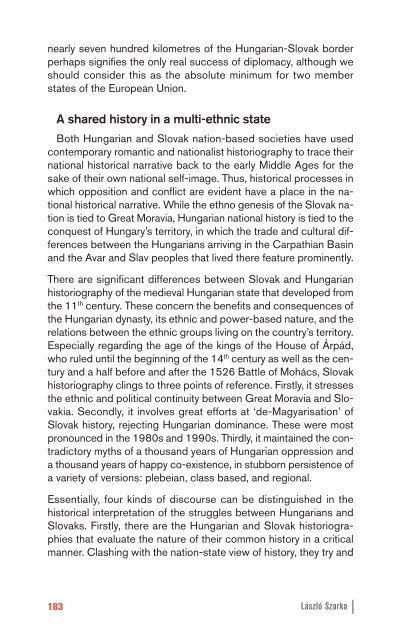Politics of the past: the use and abuse of history - Socialists ...
Politics of the past: the use and abuse of history - Socialists ...
Politics of the past: the use and abuse of history - Socialists ...
You also want an ePaper? Increase the reach of your titles
YUMPU automatically turns print PDFs into web optimized ePapers that Google loves.
nearly seven hundred kilometres <strong>of</strong> <strong>the</strong> Hungarian-Slovak border<br />
perhaps signifies <strong>the</strong> only real success <strong>of</strong> diplomacy, although we<br />
should consider this as <strong>the</strong> absolute minimum for two member<br />
states <strong>of</strong> <strong>the</strong> European Union.<br />
A shared <strong>history</strong> in a multi-ethnic state<br />
Both Hungarian <strong>and</strong> Slovak nation-based societies have <strong>use</strong>d<br />
contemporary romantic <strong>and</strong> nationalist historiography to trace <strong>the</strong>ir<br />
national historical narrative back to <strong>the</strong> early Middle Ages for <strong>the</strong><br />
sake <strong>of</strong> <strong>the</strong>ir own national self-image. Thus, historical processes in<br />
which opposition <strong>and</strong> conflict are evident have a place in <strong>the</strong> national<br />
historical narrative. While <strong>the</strong> ethno genesis <strong>of</strong> <strong>the</strong> Slovak nation<br />
is tied to Great Moravia, Hungarian national <strong>history</strong> is tied to <strong>the</strong><br />
conquest <strong>of</strong> Hungary’s territory, in which <strong>the</strong> trade <strong>and</strong> cultural differences<br />
between <strong>the</strong> Hungarians arriving in <strong>the</strong> Carpathian Basin<br />
<strong>and</strong> <strong>the</strong> Avar <strong>and</strong> Slav peoples that lived <strong>the</strong>re feature prominently.<br />
There are significant differences between Slovak <strong>and</strong> Hungarian<br />
historiography <strong>of</strong> <strong>the</strong> medieval Hungarian state that developed from<br />
<strong>the</strong> 11 th century. These concern <strong>the</strong> benefits <strong>and</strong> consequences <strong>of</strong><br />
<strong>the</strong> Hungarian dynasty, its ethnic <strong>and</strong> power-based nature, <strong>and</strong> <strong>the</strong><br />
relations between <strong>the</strong> ethnic groups living on <strong>the</strong> country’s territory.<br />
Especially regarding <strong>the</strong> age <strong>of</strong> <strong>the</strong> kings <strong>of</strong> <strong>the</strong> Ho<strong>use</strong> <strong>of</strong> Árpád,<br />
who ruled until <strong>the</strong> beginning <strong>of</strong> <strong>the</strong> 14 th century as well as <strong>the</strong> century<br />
<strong>and</strong> a half before <strong>and</strong> after <strong>the</strong> 1526 Battle <strong>of</strong> Mohács, Slovak<br />
historiography clings to three points <strong>of</strong> reference. Firstly, it stresses<br />
<strong>the</strong> ethnic <strong>and</strong> political continuity between Great Moravia <strong>and</strong> Slovakia.<br />
Secondly, it involves great efforts at ‘de-Magyarisation’ <strong>of</strong><br />
Slovak <strong>history</strong>, rejecting Hungarian dominance. These were most<br />
pronounced in <strong>the</strong> 1980s <strong>and</strong> 1990s. Thirdly, it maintained <strong>the</strong> contradictory<br />
myths <strong>of</strong> a thous<strong>and</strong> years <strong>of</strong> Hungarian oppression <strong>and</strong><br />
a thous<strong>and</strong> years <strong>of</strong> happy co-existence, in stubborn persistence <strong>of</strong><br />
a variety <strong>of</strong> versions: plebeian, class based, <strong>and</strong> regional.<br />
Essentially, four kinds <strong>of</strong> discourse can be distinguished in <strong>the</strong><br />
historical interpretation <strong>of</strong> <strong>the</strong> struggles between Hungarians <strong>and</strong><br />
Slovaks. Firstly, <strong>the</strong>re are <strong>the</strong> Hungarian <strong>and</strong> Slovak historiographies<br />
that evaluate <strong>the</strong> nature <strong>of</strong> <strong>the</strong>ir common <strong>history</strong> in a critical<br />
manner. Clashing with <strong>the</strong> nation-state view <strong>of</strong> <strong>history</strong>, <strong>the</strong>y try <strong>and</strong><br />
183 László Szarka





